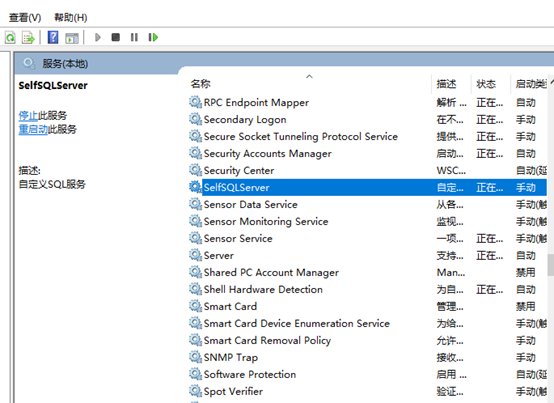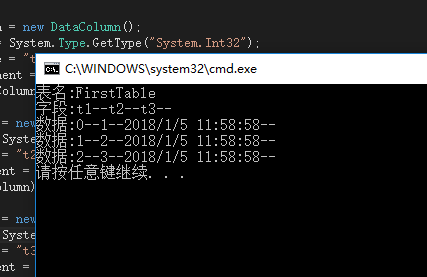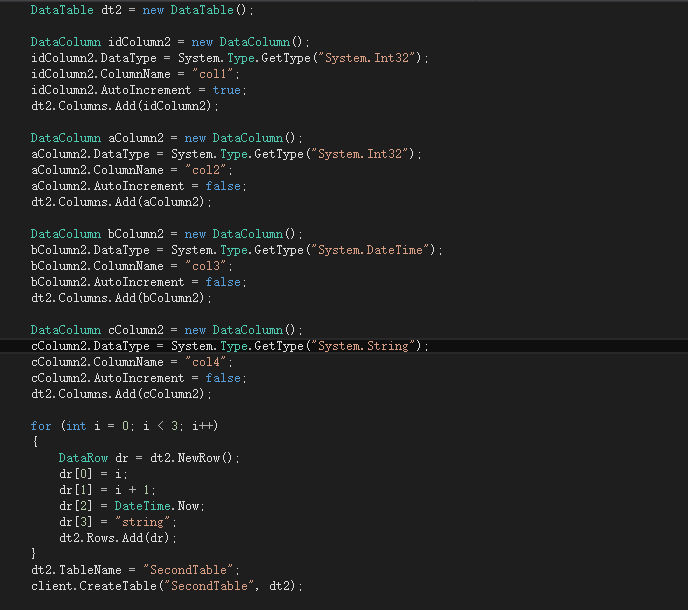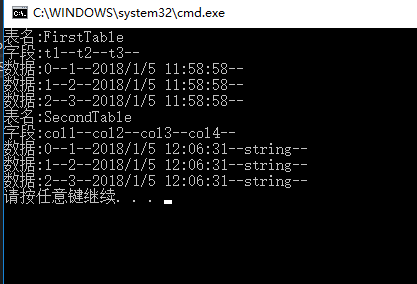自定义“缓存数据库”
前言:首先声明,此文题目算是标题党的一种,是本人为了完成与widows服务通信编程学习幻想出来的一个模型(并不是真的缓存数据库),并且会作为本人以后加深多线程、设计模式、非关系型数据库等方面学习的一个模型实例,毕竟有一个实际的模型更容易加深理解。
完成这部分模型,大概会做一下几件事情:
1、 创建一个Windows服务(用来寄存这个“缓存数据库”)
2、 创建一个WCF服务,寄宿在windows服务中(用于跟客户端通信,对“缓存数据库”进行增删查操作)
3、 创建客户端进行测试
第1步:WCF服务的创建及对缓存对象增删查的实现
WCF服务创建的过程及其Endpoint节点相关基础在这里不作累述,网上很多资料,这里直接贴Contract及其实现的代码,保存表数据的数据结构是Dictionary<string,DataTable>,其中key存放是表名,DataTable存放是数据。
1 using System;
2
3 using System.Collections.Generic;
4
5 using System.Data;
6
7 using System.Linq;
8
9 using System.Runtime.Serialization;
10
11 using System.ServiceModel;
12
13 using System.ServiceModel.Web;
14
15 using System.Text;
16
17
18
19 namespace SelfWcfService
20
21 {
22
23 // 注意: 使用“重构”菜单上的“重命名”命令,可以同时更改代码和配置文件中的接口名“IService1”。
24
25 [ServiceContract]
26
27 public interface ISelfSQLData
28
29 {
30
31 [OperationContract]
32
33 ExcuteResult CreateTable(string tableName, DataTable colNames);
34
35
36
37 [OperationContract]
38
39 ExcuteResult Insert(string tableName, SelfDataRow dr);
40
41
42
43 [OperationContract]
44
45 ExcuteResult Delete(string tableName, SelfDataRow dr);
46
47
48
49 [OperationContract]
50
51 ExcuteResult DropTable(string tableName);
52
53
54
55 [OperationContract]
56
57 Dictionary<string, DataTable> GetData();
58
59 }
60
61
62
63 [DataContract]
64
65 public class SQLData
66
67 {
68
69 [DataMember]
70
71 public Dictionary<string, DataTable> DataTables { get; set; }
72
73 }
74
75
76
77 [DataContract]
78
79 public class SelfDataRow
80
81 {
82
83 [DataMember]
84
85 public DataTable DataTable { get; set; }
86
87 }
88
89 }
接口实现部分:
1 using System;
2
3 using System.Collections.Generic;
4
5 using System.Data;
6
7 using System.Linq;
8
9 using System.Runtime.Serialization;
10
11 using System.ServiceModel;
12
13 using System.ServiceModel.Web;
14
15 using System.Text;
16
17
18
19 namespace SelfWcfService
20
21 {
22
23 // 注意: 使用“重构”菜单上的“重命名”命令,可以同时更改代码、svc 和配置文件中的类名“Service1”。
24
25 // 注意: 为了启动 WCF 测试客户端以测试此服务,请在解决方案资源管理器中选择 Service1.svc 或 Service1.svc.cs,然后开始调试。
26
27 public class SelfSQLData : ISelfSQLData
28
29 {
30
31 private static SQLData _sqlData;
32
33 public static SQLData SqlData
34
35 {
36
37 get
38
39 {
40
41 if (_sqlData == null)
42
43 {
44
45 _sqlData = new SQLData();
46
47 }
48
49 if (_sqlData.DataTables == null)
50
51 {
52
53 _sqlData.DataTables = new Dictionary<string, System.Data.DataTable>();
54
55 }
56
57 return _sqlData;
58
59 }
60
61 set
62
63 {
64
65 _sqlData = value;
66
67 }
68
69 }
70
71
72
73 private void InitalSqlData()
74
75 {
76
77 if (_sqlData == null)
78
79 {
80
81 _sqlData = new SQLData();
82
83 }
84
85 if (_sqlData.DataTables == null)
86
87 {
88
89 _sqlData.DataTables = new Dictionary<string, System.Data.DataTable>();
90
91 }
92
93 }
94
95
96
97 public ExcuteResult CreateTable(string tableName, DataTable colNames)
98
99 {
100
101 if (string.IsNullOrWhiteSpace(tableName))
102
103 {
104
105 return new ExcuteResult(1, "表名不能为空!");
106
107 }
108
109 if (colNames == null || colNames.Columns.Count < 1)
110
111 {
112
113 return new ExcuteResult(1, "表字段不能为空!");
114
115 }
116
117 InitalSqlData();
118
119 if (!_sqlData.DataTables.ContainsKey(tableName))
120
121 {
122
123 try
124
125 {
126
127 _sqlData.DataTables.Add(tableName, colNames);
128
129 }
130
131 catch (Exception ex)
132
133 {
134
135 return new ExcuteResult(1, ex.Message);
136
137 }
138
139 return new ExcuteResult(0, "表" + tableName + "创建成功!");
140
141 }
142
143 else
144
145 {
146
147 return new ExcuteResult(1, "已存在名为'" + tableName + "'的表");
148
149 }
150
151 }
152
153
154
155 public ExcuteResult Insert(string tableName, SelfDataRow dr)
156
157 {
158
159 if (string.IsNullOrWhiteSpace(tableName))
160
161 {
162
163 return new ExcuteResult(1, "表名不能为空!");
164
165 }
166
167 if (dr == null)
168
169 {
170
171 return new ExcuteResult(1, "不能插入空的数据行!");
172
173 }
174
175 InitalSqlData();
176
177 if (!_sqlData.DataTables.ContainsKey(tableName))
178
179 {
180
181 try
182
183 {
184
185 _sqlData.DataTables[tableName].Rows.Add(dr.DataTable.Rows[0]);
186
187 }
188
189 catch (Exception ex)
190
191 {
192
193 return new ExcuteResult(1, ex.Message);
194
195 }
196
197 return new ExcuteResult(0, "数据新增成功!");
198
199 }
200
201 else
202
203 {
204
205 return new ExcuteResult(1, "表'" + tableName + "'不存在!");
206
207 }
208
209 }
210
211
212
213 public ExcuteResult Delete(string tableName, SelfDataRow dr)
214
215 {
216
217 if (string.IsNullOrWhiteSpace(tableName))
218
219 {
220
221 return new ExcuteResult(1, "表名不能为空!");
222
223 }
224
225 if (dr == null)
226
227 {
228
229 return new ExcuteResult(1, "请指定删除对象!");
230
231 }
232
233 InitalSqlData();
234
235 if (!_sqlData.DataTables.ContainsKey(tableName))
236
237 {
238
239 try
240
241 {
242
243 _sqlData.DataTables[tableName].Rows.Remove(dr.DataTable.Rows[0]);
244
245 }
246
247 catch (Exception ex)
248
249 {
250
251 return new ExcuteResult(1, ex.Message);
252
253 }
254
255 return new ExcuteResult(0, "数据删除成功!");
256
257 }
258
259 else
260
261 {
262
263 return new ExcuteResult(1, "表'" + tableName + "'不存在!");
264
265 }
266
267 }
268
269
270
271 public ExcuteResult DropTable(string tableName)
272
273 {
274
275 if (string.IsNullOrWhiteSpace(tableName))
276
277 {
278
279 return new ExcuteResult(1, "表名不能为空!");
280
281 }
282
283 InitalSqlData();
284
285 if (!_sqlData.DataTables.ContainsKey(tableName))
286
287 {
288
289 try
290
291 {
292
293 _sqlData.DataTables.Remove(tableName);
294
295 }
296
297 catch (Exception ex)
298
299 {
300
301 return new ExcuteResult(1, ex.Message);
302
303 }
304
305 return new ExcuteResult(0, "表" + tableName + "删除成功!");
306
307 }
308
309 else
310
311 {
312
313 return new ExcuteResult(1, "表'" + tableName + "'不存在!");
314
315 }
316
317 }
318
319
320
321 public Dictionary<string, DataTable> GetData()
322
323 {
324
325 return SqlData.DataTables;
326
327 }
328
329 }
330
331 }
整个WCF实现的逻辑都在上面了,web配置文件不需要改,因为它不以web的形式发布寄宿在IIS中,而是windows服务中。
第2步:将WCF寄宿在Windows服务中
Windows服务的创建、安装、启动在这里也不作累述,跟WCF一样,网上资料也很多。这里重点介绍一下将WCF寄宿在Windows服务中。
(1) 将wcf项目的dll引用到windows服务项目中

(2) 在app.config文件中配置WCF终结点
1 <system.serviceModel> 2 3 <services> 4 5 <service behaviorConfiguration="BasicServiceBehavior" 6 7 name="SelfWcfService.SelfSQLData"> 8 9 <endpoint address="" binding="netTcpBinding" bindingConfiguration="" 10 11 contract="SelfWcfService.ISelfSQLData"> 12 13 <!--<identity> 14 15 <dns value="192.168.1.4" /> 16 17 </identity>--> 18 19 </endpoint> 20 21 <endpoint address="mex" binding="mexTcpBinding" bindingConfiguration="" 22 23 contract="IMetadataExchange" /> 24 25 <host> 26 27 <baseAddresses> 28 29 <add baseAddress="net.tcp://localhost:9000/SelfSQLData.svc"/> 30 31 <add baseAddress="http://localhost:9001/SelfSQLData.svc"/> 32 33 </baseAddresses> 34 35 </host> 36 37 </service> 38 39 </services> 40 41 <behaviors> 42 43 <serviceBehaviors> 44 45 <behavior name="BasicServiceBehavior"> 46 47 <serviceMetadata httpGetEnabled="true" /> 48 49 <serviceDebug includeExceptionDetailInFaults="true" /> 50 51 </behavior> 52 53 </serviceBehaviors> 54 55 </behaviors> 56 57 <serviceHostingEnvironment aspNetCompatibilityEnabled="true" multipleSiteBindingsEnabled="true" minFreeMemoryPercentageToActivateService="0" /> 58 59 <bindings> 60 61 <netTcpBinding> 62 63 <binding name="defaultBinding" maxBufferSize="2147483647" maxBufferPoolSize="2147483647" maxReceivedMessageSize="2147483647"> 64 65 <security mode="None"> 66 67 <message clientCredentialType="None"/> 68 69 <transport clientCredentialType="None"></transport> 70 71 </security> 72 73 <readerQuotas /> 74 75 </binding> 76 77 </netTcpBinding> 78 79 </bindings> 80 81 </system.serviceModel>
(3) 在windows服务启动的时候启动WCF服务
1 using SelfHelper;
2
3 using System;
4
5 using System.Collections.Generic;
6
7 using System.ComponentModel;
8
9 using System.Data;
10
11 using System.Diagnostics;
12
13 using System.Linq;
14
15 using System.ServiceProcess;
16
17 using System.Text;
18
19 using System.ServiceModel;
20
21
22
23 namespace SelfSQL
24
25 {
26
27 public partial class SelfSQLServer : ServiceBase
28
29 {
30
31 public SelfSQLServer()
32
33 {
34
35 InitializeComponent();
36
37 }
38
39
40
41 ServiceHost host = new ServiceHost(typeof(SelfWcfService.SelfSQLData));
42
43 protected override void OnStart(string[] args)
44
45 {
46
47 LogWriter.WriteLog("服务已启动!");
48
49 try
50
51 {
52
53 host.Open();
54
55 LogWriter.WriteLog("WCF启动成功");
56
57 }
58
59 catch (Exception ex)
60
61 {
62
63 LogWriter.WriteLog("WCF启动异常:" + ex.ToString());
64
65 }
66
67
68
69 }
70
71
72
73 protected override void OnStop()
74
75 {
76
77 LogWriter.WriteLog("服务已停止!");
78
79 }
80
81 }
82
83 }
(4) 启动windows服务进行测试


第3步:创建客户端进行测试
首先在控制台程序中添加服务引用

然后就可以调用客户端对象进行测试了。
测试代码:
1 using System;
2
3 using System.Collections.Generic;
4
5 using System.Data;
6
7 using System.Linq;
8
9 using System.Text;
10
11
12
13 namespace SelfSQLClient
14
15 {
16
17 class Program
18
19 {
20
21 static void Main(string[] args)
22
23 {
24
25 SelfSQLServiceCilent.SelfSQLDataClient client = new SelfSQLServiceCilent.SelfSQLDataClient();
26
27 DataTable dt1 = new DataTable();
28
29
30
31 DataColumn idColumn = new DataColumn();
32
33 idColumn.DataType = System.Type.GetType("System.Int32");
34
35 idColumn.ColumnName = "t1";
36
37 idColumn.AutoIncrement = true;
38
39 dt1.Columns.Add(idColumn);
40
41
42
43 DataColumn aColumn = new DataColumn();
44
45 aColumn.DataType = System.Type.GetType("System.Int32");
46
47 aColumn.ColumnName = "t2";
48
49 aColumn.AutoIncrement = false;
50
51 dt1.Columns.Add(aColumn);
52
53
54
55 DataColumn bColumn = new DataColumn();
56
57 bColumn.DataType = System.Type.GetType("System.DateTime");
58
59 bColumn.ColumnName = "t3";
60
61 bColumn.AutoIncrement = false;
62
63 dt1.Columns.Add(bColumn);
64
65
66
67 for (int i = 0; i < 3; i++)
68
69 {
70
71 DataRow dr = dt1.NewRow();
72
73 dr[0] = i;
74
75 dr[1] = i + 1;
76
77 dr[2] = DateTime.Now;
78
79 dt1.Rows.Add(dr);
80
81 }
82
83 dt1.TableName = "FirstTable";
84
85 client.CreateTable("FirstTable", dt1);
86
87
88
89 Dictionary<string, DataTable> dts = client.GetData();
90
91 foreach (var dt in dts)
92
93 {
94
95 Console.WriteLine("表名:" + dt.Key);
96
97 string colNames = string.Empty;
98
99 foreach (var col in dt.Value.Columns)
100
101 {
102
103 colNames += col.ToString() + "--";
104
105 }
106
107 Console.WriteLine("字段:" + colNames);
108
109 foreach (DataRow val in dt.Value.Rows)
110
111 {
112
113 string vals = string.Empty;
114
115 for (int i = 0; i < dt.Value.Columns.Count; i++)
116
117 {
118
119 vals += val[i] + "--";
120
121 }
122
123 Console.WriteLine("数据:" + vals);
124
125 }
126
127 }
128
129 }
130
131 }
132
133 }
输出结果:

添加SecondTable表:

输出结果:

总结:
到这里相信大家都知道了,所谓的“缓存数据库”不过是个数据结构为Dictionary<string,DataTable>的静态变量而已,有人可能要问,直接定义在应用程序中不就完事了吗?还有必要又是创建WCF服务,又是创建Windows服务的吗?当然,在这里像玩具一般的“缓存数据库”确实没必要这么大费周章,它并不友好,要新增数据需要大量初始化DataTable对象的代码,它也承载不了太大的数据量,毕竟内存依旧在CLR托管堆中,它的稳定性与安全性更是无从谈起,因为毫无并发量较高的逻辑处理,但是,我做这件事情的初衷,并不是要写一个可以匹敌类似于redis一样的数据库,而是如前言所说,正因为这个“玩具”它存在这么多的缺陷,那么对这些缺陷进行一定程度完善的过程,也是加深对多线程、设计模式、非关系型数据库等方面学习的一个过程。





 浙公网安备 33010602011771号
浙公网安备 33010602011771号